CHAPTER SIX
PLANETS INHABITED BY MAN
THE GLIPTOLITHIC WORLD
I possess a series of gliptoliths that
have engraved upon them seas and continents of the hemispheres of a planet. In
each gliptolith a hemisphere is represented. These gliptoliths are approximately
seventy centimeters in diameter, dark in color and engraved with the deep
scoring technique in relief.
The engravings represent observations
of a planet from a great height, etched on these stone documents to show a
peculiar set of continents that do not correspond to the shape of the continents
on our planet (Figs. 59 and 60).
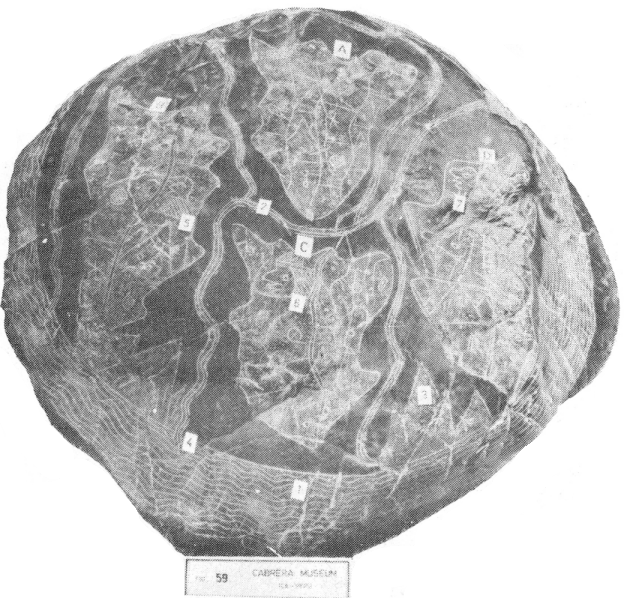
FIGURE 59: First Terrestrial
Hemisphere: An engraved stone that reveals the position and shape that the
continents had in one of the hemispheres of our
planet in the remote past in which the gliptolithic humanity existed. A: North
America. C: South America. B: The Continent of Mu. D: The Continent of Atlantis.
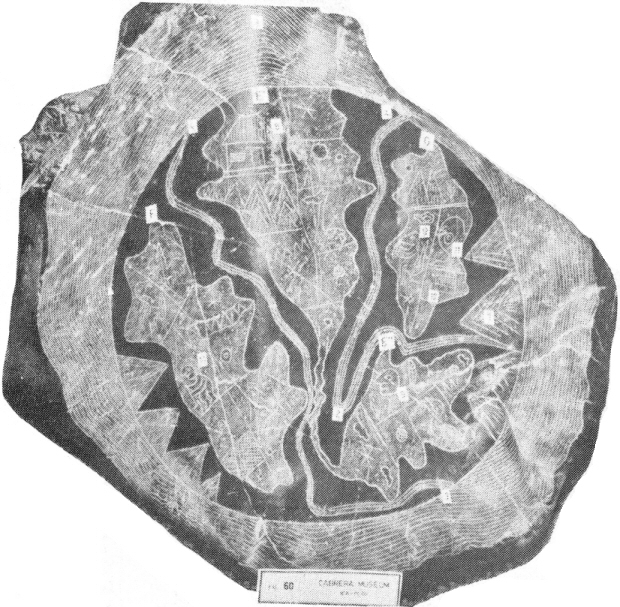
FIGURE 60: Second Terrestrial
Hemisphere: Another engraved stone that reveals the position and form of the
continents in the other hemisphere
of our planet in the distant past in which the gliptolithic humanity existed. G:
The Continent of Lemuria. E' : Anterior Asia. E" Australia. F:
Africa.
On the surface of the first hemisphere
four major masses can be seen, and on the second, three. All these masses are
suggestive of solid surfaces or continents, differentiated from the zones that
lie between the masses and that obviously represent seas. It can be estimated
that the continental masses make up approximately 80 percent of the surface of
the hemispheres while the remaining 20 percent is made up of seas. It is thus
understood that there are four parts of land to every one of water. There are no
symbols representing water in its solid state (ice), and therefore there seem to
be no icecaps on these hemispheres. Around the group of continents and seas a
large belt of undulating lines can be seen. If the relative scarcity of water in
relation to the continental masses is considered, it is understood that an
intense evaporation of the seas has taken place and that the belt of undulating
lines is simply a representation of the accumulation of water vapor in the
atmosphere. If, on the other hand, some canals of undulating lines are observed
connected to the atmosphere and stretching over the seas (2 in
Figs. 59 and 60), it can be deduced that these
canals indicate that the evaporation continues and that the vapor keeps
ascending into the atmosphere where it accumulates.
Given the gigantic proportions of the
covering of water vapor in the atmosphere it seems plausible to deduce that the
planet that is being shown was passing through a stage of intense thermic
energy. As is obvious, a huge cap of vapor presupposes the concentration of a
large amount of energy in it. According to what I have found in the system of
symbols used in the gliptolithic massages, the energy to which I have referred
is represented in this stone by the undulating lines that can be observed in the
atmosphere. The network of canals that are connected to the atmosphere and that
stretch out over the seas acquire additional significance when this is realized:
part of the energy that exists in the atmosphere in being channeled toward the
continents through the canals. Finally, if it is observed that the pyramids -
symbols of a system for capturing, accumulating and distributing energy - have
their bases oriented towards the atmosphere and their vertices pointing towards
the continents (3 in Figs. 59 and 60), it is
certain that they are indicating that part of the energy of the atmosphere is
being captured in a complex technological system, for specified uses.
All this signifies that the planet
represented by these two hemispheres is in critical condition because of the
progressive accumulation of the aforementioned calorific energy. These critical
circumstances suggest that a cataclysmic event is imminent.
Having discussed the general situation
of the planet represented on these two stones, I will explain the symbols that
appear in each major block of each of the hemispheres.
FIRST HEMISPHERE
Block A. This block (Fig.
61) presents a mass divided into fifteen compartments, among which two
can be seen that contain natural vegetation {represented by parallel lines), and
one with animals raised by man (represented by small rhomb-like figures enclosed
in a circle). There is no sign of human life. There are pyramids, symbols of the
use of energy in this part of the continent; these appear between two electrical
power stations (represented by stars), that are in the middle part of the block.
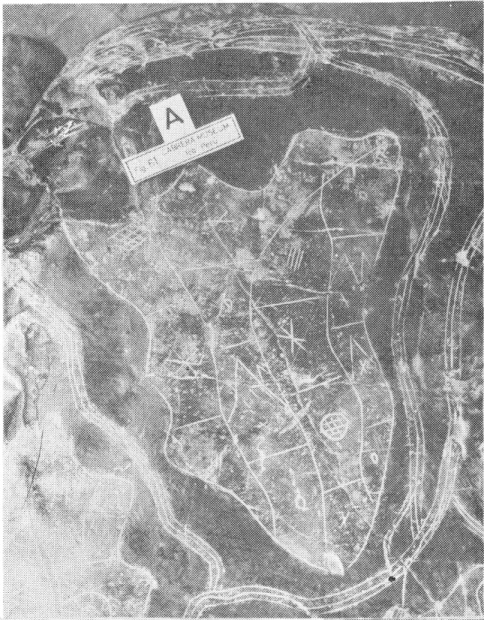
FIGURE 61 Block A: North America,
a detail of the first terrestrial hemisphere.
Block B. This block (Fig.
62) is divided into nine compartments, the majority of which correspond
to desert zones. There are two compartments filled with natural vegetation
(symbolized by parallel lines on the ground) and two compartments filled with
animals raised by man (represented by the rhomb-like figures enclosed in
circles). Notable in this block is an anthropomorphic figure (5 in
Fig. 62). The absence of symbols on his head that
indicate cognitive capacity, and the presence of parallel lines on the body, a
symbol of cognitive capacity that is given and controlled by another, reveal
that this is a robot. In this block the existence of a robot must be interpreted
to signify the existence of intellectual activity performed by a group of
robots. The ground is crossed longitudinally by a canal, a symbol of the
movement of energy that is being liberated from the atmosphere. This liberated
energy is being controlled permanently by the robots, as is indicated
symbolically by the contact that the nose of the robot makes with the canal.
There are pyramids - symbols of the use of energy - on this part of the
continent very close to the zone controlled by the robots. It is obvious that in
this block there is an attitude of hope attributed to the robots for the
critical situation of the energy that is being produced on the planet.
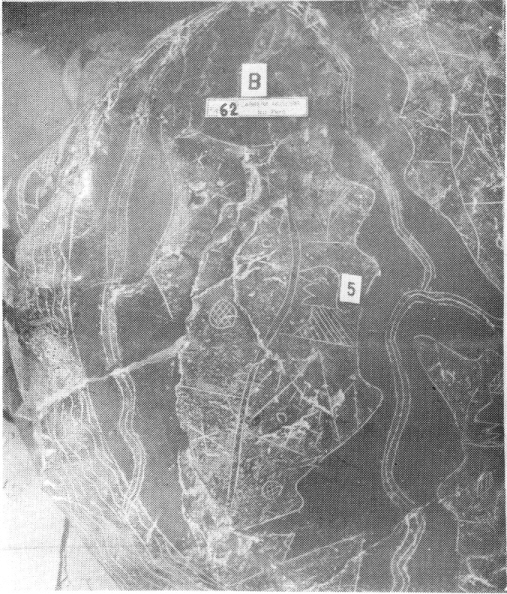
FIGURE 62 Block B: The continent
of Mu, detail from the first terrestrial hemisphere.
Block C. In this block (Fig.
63) the singular presence of the cognitive and scientific individual (6
in Fig. 63) with the symbol for cognitive thought
on his head can be seen. The size of this figure indicates that there is a
formidable concentration of cognitive and scientific men that lived in this vast
region that constituted the Megapolis (37). The Megapolis is represented in the
block by the square around the head of the human figure, isolating it in this
way from the other compartments of the block. Around the Megapolis there are
extensive zones of vegetation cultivated by man (represented by the parallel
lines inside a cube), which suggests the existence of agriculture and the
enrichment of the atmosphere with oxygen. There are no symbols for the existence
of animal life. There are three electric power stations (represented by stars)
some distance from the Megapolis. The block is divided into thirteen
compartments and has, as a symbol for the fact that energy is being liberated
from the atmosphere, a long canal similar to the one in Block B, being
connected, however, to the network of canals that stretches out over the sea of
the hemisphere.
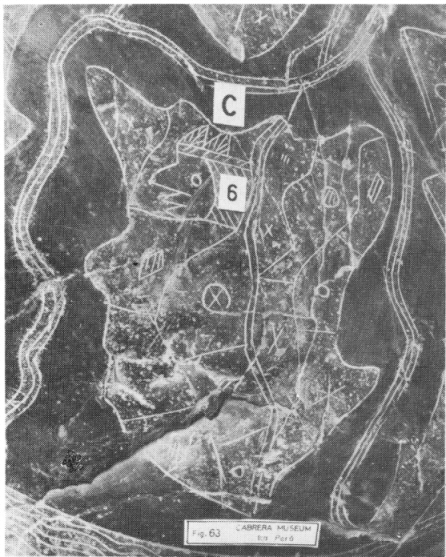
FIGURE 63 Block C: South America,
detail from the first terrestrial hemisphere.
Block D. The territory in this block (Fig.
64) is divided into ten compartments. Unfortunately, many of the symbols
of those closets to the edge of the gliptolith have been erased. Nevertheless,
it can be observed that this is a territory with abundant natural and cultivated
vegetation, judging by the zones of parallel lines that are free and the
parallel lines enclosed in squares respectively. In addition, there are symbols
that reveal zones populated by animals raised by man, and specifically, the head
and neck of an animal can be seen, the "alticamellus" (38). Two energy stations
can be clearly distinguished, symbolized by stars, one of which is very close to
a mountainous region and is connected to two canals that conduct energy from the
atmosphere. The dominant figure in the gliptolith is that of an anthropomorphic
figure (7 in Fig. 64). Judging by the absence of
symbols on its head it can be deduced to be a humanoid (notharctus with a
minimum intellectual capacity, with which he cannot yet realize that the reason
for his existence is to increase and conserve knowledge). By the size of this
anthropomorphic figure it can be deduced that this is a group of humanoids.
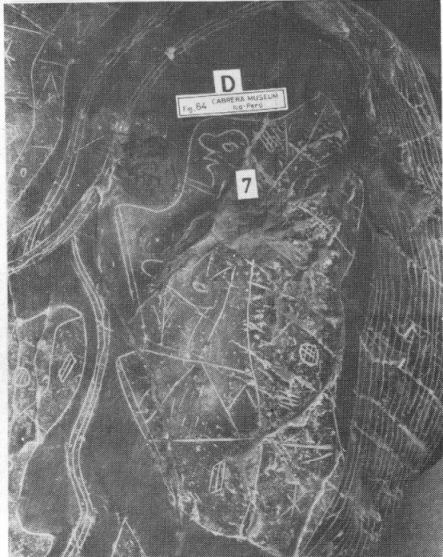
FIGURE 64: Block D: The continent
of Atlantis, a detail of the first terrestrial hemisphere.
SECOND HEMISPHERE
Block E. This represents the largest of
all the blocks. Its central section is so narrow that the block seems to be made
up of two sub-blocks unified by a bridge. For this reason we will divide it into
two sections: sub-block E' and sub-block E".
Sub-block E’. This is formed by eight
compartments (Fig. 65). In one of these there
appears a house (8 in Fig. 65). The rhomb-shape
figures that can be seen in the window are a symbol of animal life, and the
parallel lines and vertices of the roof are symbols of cognitive codes used for
training of technical knowledge. All this indicates that this is the house where
the notharctus receive the minimum of intellectual capacity and are raised to
the level of humanoids, which allows them to carry on menial tasks and very
specific technical tasks. In this block a mountain system can be seen close to
an energy station (represented by a star). Two large pyramids can be seen,
symbol of a technological energy complex. Close to the figure of the house there
is a tree between two pyramids, a symbol for the fact that industrial factories
exist here. The alticamellus can also be seen, as in Block D, whose complete
body signifies - as distinct from Block C where only the head appeared- the
rearing of these animals. The flat circle full of rhomb-shaped figures that
appears in one of the lower compartments symbolizes the rearing of animals. In
this whole block the impression is of intense human farming and ranching
activity.
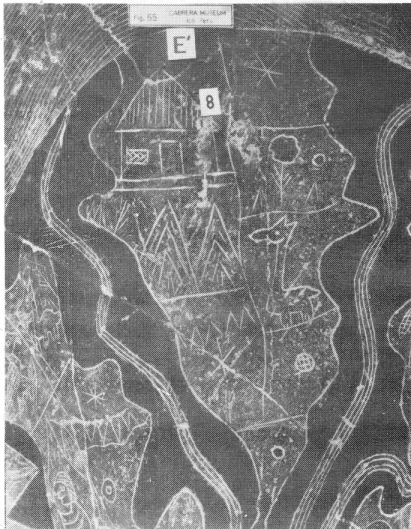
FIGURE 65: Sub-block E':
Anterior Asia, detail from the second terrestrial hemisphere.
Sub-block E". In this block there are
five compartments (Fig. 66), in one of which an
anthropomorphic figure can be seen (9 in Fig. 66). The vertical parallel lines
that cover him below the head signify that it has acquired a minimum of
technical knowledge, characteristic of a humanoid (remember the same lines
appearing on the roof of the house of Sub-block E’). However, the presence of
two leaves in between which this figure stands - the first of which appears
without nervation - expresses that this humanoid is being elevated to a higher
cognitive rank of a technological type. This therefore is no longer a humanoid,
but rather an anthropomorphic being that is being led to the level of cognizance
immediately superior to his own, that can be no other than a technological man,
conscious therefore of the reason for his existence. The nearby figure of a bird
allows us to infer the existence of installations for aerial transport. The
trees and the rhomb-shaped figures inside a circle allow us to infer the
existence of zones of vegetable farming and animal raising. Two sources of water
are found (represented by small spaces enclosed by a winding line) and an energy
station (represented by the figure of a star).
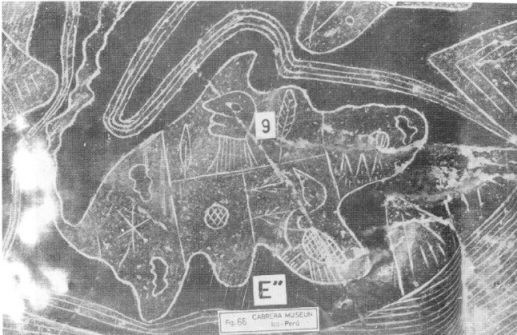
FIGURE 66: Sub-block E":
Australia, detail from the second terrestrial hemisphere.
Block F. This block contains nine
compartments (Fig. 67). In the superior part of the
block, symbols that refer to a flying apparatus (bird) can be seen, probably
used for the transport of animal feed, as well as a symbol of land
transportation (the alticamellus, that is found between two trees) to transport
vegetable products. Associated to these symbols are the figures of two leaves
that represent nutritive elements for human life. We are dealing, then, in this
superior part of the block, with a symbolic complex that reveals the activity of
transporting food for human consumption. In one of the compartments there is an
anthropomorphic figure (10 in Fig. 67), that ports
on his head a symbol of high intellectual and cognitive rank. Observe the two
pyramids - symbols of the technological complex used to capturing, accumulate
and distribute energy - that appear above the anthropomorphic figure. This, in
addition to the fact that the figure seems to be wielding some sort of
instrument, should be understood to mean that this individual is in charge of a
complex energy system, which requires high intellectual capacity. We have here,
then a different type of man from the simply technological man: a reflective
technological man. Close to the two pyramids there is a chain of small pyramids.
Above this chain there is a star, symbol of the existence of an energy station.
Under the chain of pyramids there are two concentric circles, symbol of a
spacecraft. Its proximity to the chain of pyramids implies the presence in the
zone of a "spaceport" (space center). In the section immediately below the
intellectual technological man appears the symbol for vegetable life controlled
by man (parallel lines enclosed in a circle). The whole section below the
previous one has symbols of wild animals (represented by rhomb-like figures that
fill up the whole section). Two large new pyramids that touch the above
mentioned compartments indicate that the agriculture and animal raising involved
is to be used in industry of some kind.
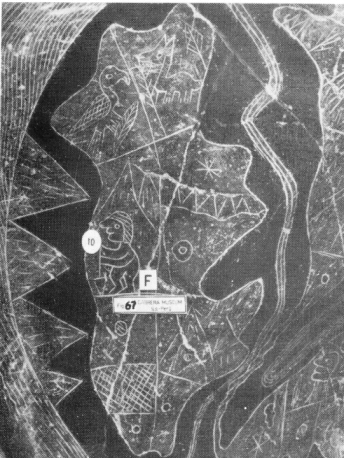
FIGURE 67: Block F: Africa,
detail of the second terrestrial hemisphere.
Block G. This is the smallest block of
all (Fig. 68). It consists of four compartments, in
one of which the figure of a notharctus can be seen in its natural state (12 in
Fig. 68), that is, without the minimum of
intellectual ability. The notharctus touches a leaf full of small squares, a
symbol, in this case, of intellectual capacity and human rank. This can be
interpreted to mean that the notharctus is approaching the intellectual capacity
necessary to become a human. The symbol that appears in the next compartment and
that consists of two concentric circles (11 in Fig. 68)
represents a spacecraft, whose trajectory is the semicircular line that
partially surrounds the spacecraft and then begins to undulate. I think the
spacecraft is related to the symbol of intellectual and cognitive capacity that
the notharctus is touching. These are the gliptolithic men who arrived from the
cosmos to the planet with the purpose of transferring to the notharctus a
cognitive ability that would make him human. The figure of a house that can be
seen in another contiguous block (13 in Fig. 68),
that has parallel lines that can be interpreted as signifying learning or
knowledge in general, is a symbol that is also related to the cognitive energy
which the notharctus is getting close to achieving. The fact that it is a house
without doors or windows should be interpreted to signify that the actions of
the life of the notharctus will be completely different from the moment at which
he is elevated to the cognitive rank by the gliptolithic men, and that
consequently the new acts of his life will be governed by human knowledge. Thus
he will forever leave his condition as a primate. In the upper compartment there
are two large pyramids associated with a symbol whose significance I have
mentioned when I dealt with the leaf as a symbol of life. I refer to a type of
tree whose branches are associated with a central axis. This symbol indicates,
as has been mentioned before, the presence of a group of men. Associated with
the group of pyramids that indicate the presence of energy in general, it
indicates definitively that human knowledge has been established on the planet.
The figure in the shape of a cloud that appears above the notharctus I
understand as signaling that the knowledge given the notharctus comes from the
cosmos. Finally, the drawing of the star that appears in the compartment below
the notharctus and that as has been mentioned is the symbol of an energy
station, would seem to indicate that the cognitive energy come from the cosmos
will be centered in this continental block of the planet.
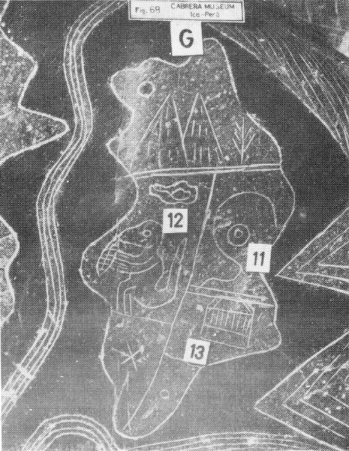
FIGURE 68: Block G: The continent
of Lemuria, detail of the second terrestrial hemisphere.
TYPES OF
MAN IN
THE GLIPTOLITHIC HUMANITY
The information provided by the
hemispheres of the planet represented in the two gliptoliths that have been
described and interpreted, reveals the existence of a planet inhabited by man
and a critical situation which that planet was experiencing.
The representation of the
characteristics of the surface of the planet presupposes the fact that the men
that inhabited it dominated space, for were it otherwise they would not have
been able to view the group of continents which they have drawn in such detail
on the two gliptoliths. Some symbols confirm that these men had dominated space
flight. These are symbols referring to spacecraft, "space-ports", the arrival of
the gliptolithic men from the cosmos and the representation of the continental
blocks and seas and the atmosphere.
These gliptoliths indicate that human
knowledge came from the cosmos, brought by the gliptolithic men with the purpose
of giving it to beings biologically more fit for it than they were. The
notharctus was the animal chosen for the reception of this knowledge, and
startup with it a hierarchy of intelligent creatures was created, in which each
creature received a cognitive level in accordance with its function on the
planet. The gliptolithic men were thus eminently knowledgeable men that needed
men to survive in this planetary habitat that were elevated to certain cognitive
levels in order to allow them to perform menial, technical or scientific tasks.
According to the information on the two gliptoliths whose symbols have just been
analyzed, the following hierarchy of intelligent human beings existed upon this
planet, in order from the beings of highest cognitive abilities.
1. Gliptolithic Man. The men who came
from the cosmos carrying with them knowledge. As will be seen in this chapter,
this is the Energyman and is therefore capable of allowing his cognitive energy
to transcend his body without his body dying. This is done to project himself as
cognitive energy to any part of the cosmos and to acquire knowledge of the
universe. In these and other gliptoliths he is found symbolically represented
with the same characteristics as the intelligent and scientific man.
2. Reflective and Scientific Man. This
is the man that lived in the Megapolis. He took on functions that required a
high reflective capacity. He directed the execution of planned activities of the
Gliptolithic men for the best development of life on the planet. He carried out
scientific work on different aspects of human knowledge, for example, high level
surgery and cosmic observation (astronomy).
3. Reflective Technological
Man. This
is the man who had a higher level of knowledge than the Technological Man. He
had as his responsibility the control and operation of all technological
operations. He carried out such tasks as piloting spacecraft, assisting in
operations of high level surgery, directing the functioning of industry and
systems for the distribution and use of energy resources.
4. Technological
Man. This
is the man at the raid level of command of technological abilities. He assisted
the intelligent and scientific man and transmitted the orders directly to the
immediate executor of the actions.
5. Humanoid. This was the notharctus
elevated to a middle level of intelligence. He performed menial and technical
tasks. He was not conscious of the reason for his existence.
Under the humanoid was the notharctus
in his natural state, who had not received the minimum rank of human intellect.
His intellectual status was that of an animal, but not that of any animal,
because in the zoological hierarchy it was he that had the optimum qualities to
be elevated to the first level of human intellect. Finally, there was the robot,
a cybernetic system used exclusively for mechanical work that was dangerous to
human beings.
I understand that for the gliptolithic
men to be able to raise the notharctus to the cognitive level of a humanoid it
was necessary for them first to prepare it organically for the increase in
knowledge and then pass on to it the required knowledge. Based on other messages
left by the gliptolithic humanity, it is my impression that they achieved this
by altering genetically the organism of the notharctus, which I assume resulted
in the elimination of the tail and the consequent abandoning of tree-life. The
transmission of knowledge was also done genetically, intervening in the
molecular makeup of the notharctus' brain. In both cases the gliptolithic men
used complex neurophysical techniques. Through the transplant of new cognitive
codes the rest of the types of men on the cognitive hierarchy were able to
exist.
The individuals on this planet,
being generated from a common biological source - the notharctus - all had
similar physiological characteristics. And being born of another common factor
among these men - the knowledge - it should then be understood that these men
were only different in the level of intellectual achievement they had reached.
Therefore, the individual differences based on other factors such as exist in
contemporary culture did not exist. What is now known as personality did not
exist; what existed was the collective personality, that is, the union of all
individuals that were on the same intellectual level in the hierarchy.
Thus it is understood that the
civilization on this planet had as its goal to reach higher levels of knowledge,
and it is to be supposed that all the acts of the lives of these men ware
devoted to increasing and conserving knowledge.
-----------------------
Footnotes:
(37) I use the word Megapolis for the
big gatherings of reflexive and scientific human beings. It is of my
understanding that these men used to live in the Megapolis with different kinds
of men dedicated to the various activities related to the life in the planet.
(38) The alticamellus was a mammiferous
that lived, according to Paleontology, 13 billion years ago in the Tertiary
period. It is the equivalent to the present camel from the desert. They were
adapted to high temperatures with restricted hydrological resources. The
alticamellus on the stone shows us – graphically - the thermo-critical situation
shown by the planet. The average temperature had been increased up to such a
point that zoological life was only possible for conditioned species.
(39) Confront "El origen de los
primeros seres humanos". In Cuentos, mitos y leyendas
del
antiguo Peru. Compiled by Jose Maria Arguedas and Francisco Izquierdo Rios.
Ministerio de Educacion (Board of Education)
Lima,
1947.
